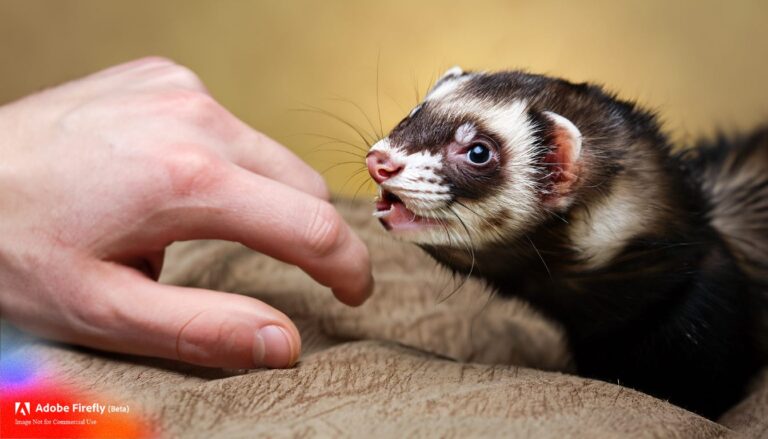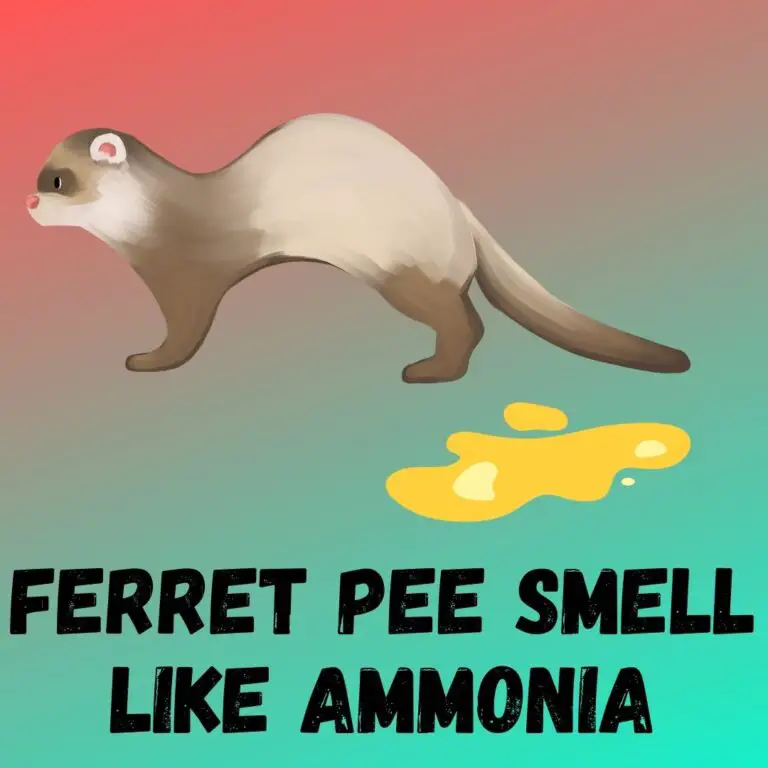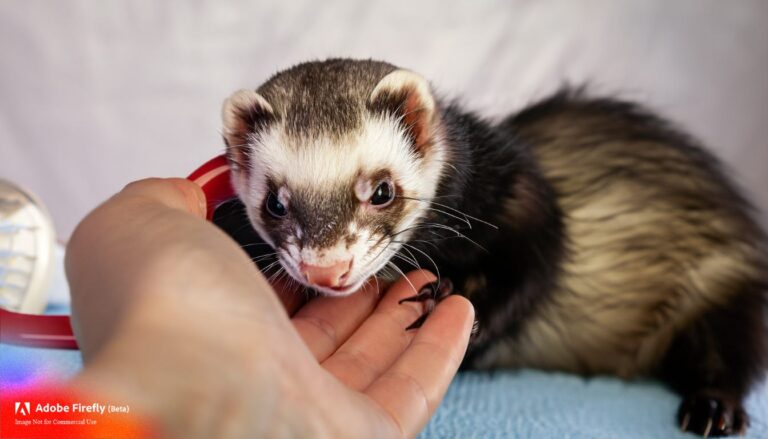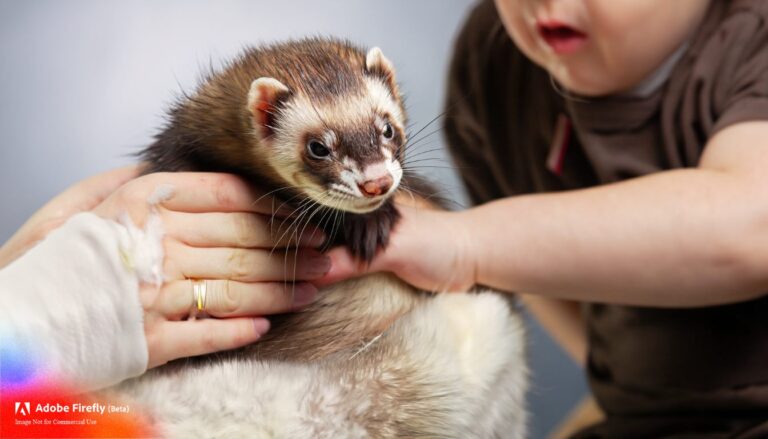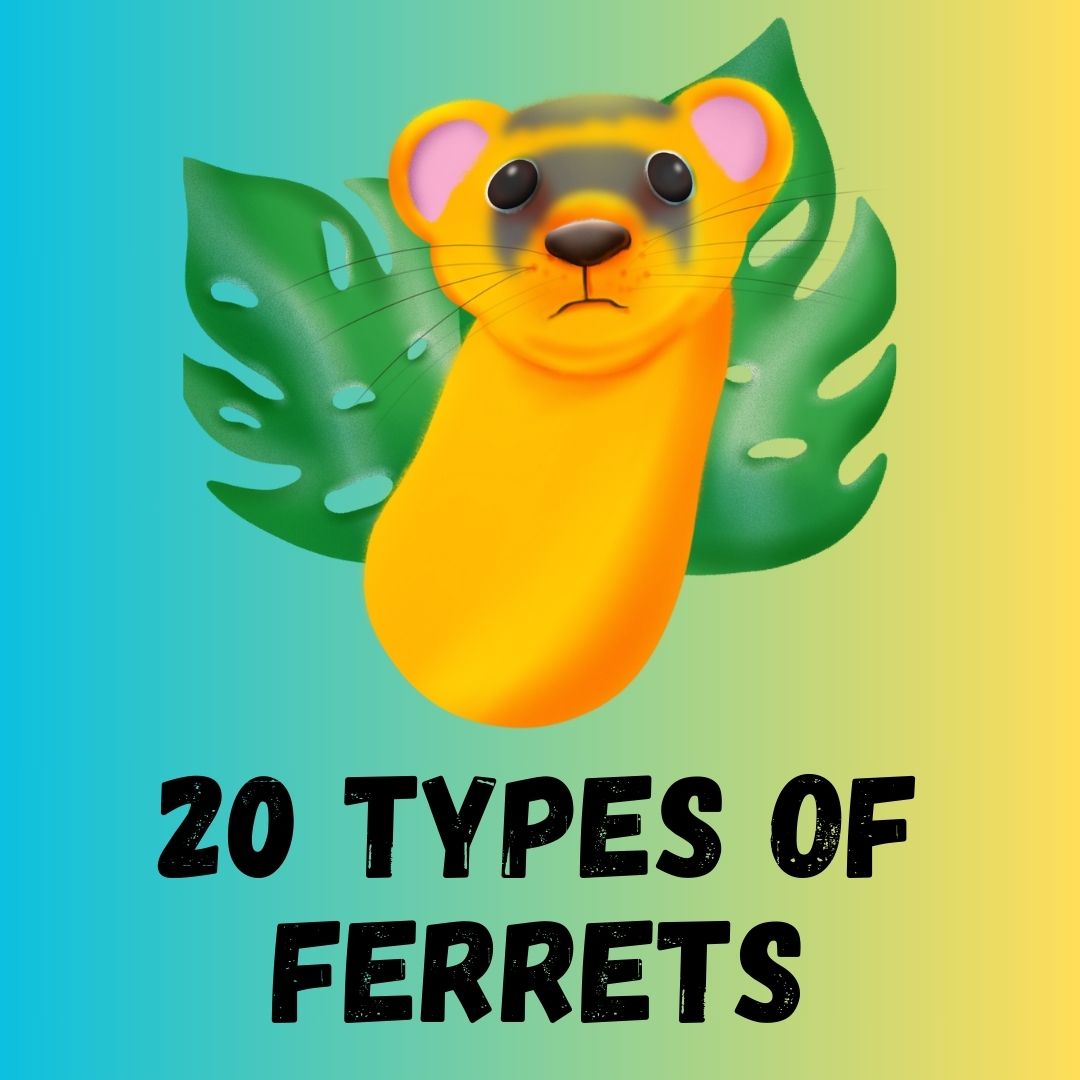
Ferrets, beloved for their playful and curious nature, come in a variety of colors and patterns, each with its unique characteristics and charm. From the classic albino to the striking panda ferret, understanding the different types of ferrets can add to the joy of ferret ownership. In this comprehensive guide, we’ll explore each type of ferret, including their colors, patterns, and distinctive features, allowing ferret enthusiasts to appreciate the beauty and diversity within the ferret community.
1. Albino Ferret:
Color: Pure white fur, pink eyes, and nose. Description: Albino ferrets lack pigmentation in their fur and eyes, resulting in their characteristic white coat and pink eyes. They are known for their striking appearance and friendly disposition. Habitat: Albino ferrets are commonly kept as indoor pets in spacious cages or enclosures equipped with bedding, toys, and hiding spots. Food: They require a diet rich in high-quality ferret kibble, supplemented with occasional treats such as raw meat or eggs. Unique Facts: Albino ferrets are more prone to sunburn and skin cancer due to their lack of pigmentation, so it’s essential to provide them with shade and protection when outdoors.
2. Sable Ferret:
Color: Rich, warm brown fur with a lighter undercoat. Description: Sable ferrets have a dark, chocolatey brown coat with a lighter underbelly. They often have a mask-like pattern on their faces, adding to their distinctive appearance. Habitat: Sable ferrets thrive in environments with plenty of enrichment, including tunnels, hammocks, and climbing structures. Food: Their diet consists of a combination of ferret kibble, fresh water, and occasional treats such as raw meat or freeze-dried fruits and vegetables. Unique Facts: Sable ferrets may exhibit a playful and mischievous personality, making them popular choices as pets for families and individuals alike.
3. Champagne Ferret:
Color: Warm, beige-toned fur with a hint of pink or gold. Description: Champagne ferrets have a soft, champagne-colored coat that ranges from light beige to pale gold. Their fur has a subtle shimmer, giving them an elegant appearance. Habitat: Champagne ferrets require a spacious and comfortable living environment with plenty of room to explore and play. Food: Their diet should consist of high-quality ferret food supplemented with occasional treats such as cooked eggs or poultry. Unique Facts: Champagne ferrets are known for their affectionate nature and may form strong bonds with their owners, enjoying cuddle sessions and interactive playtime.
4. Chocolate Ferret:
Color: Deep, chocolaty brown fur with a glossy sheen. Description: Chocolate ferrets boast a rich, dark brown coat that resembles melted chocolate. Their fur is often smooth and glossy, adding to their allure. Habitat: Chocolate ferrets thrive in environments with plenty of mental and physical stimulation, including toys, tunnels, and opportunities for exploration. Food: They require a balanced diet consisting of high-quality ferret kibble, fresh water, and occasional treats such as freeze-dried meat or raw bones. Unique Facts: Chocolate ferrets may have a playful and energetic personality, enjoying games of chase, hide-and-seek, and interactive toys.
5. Cinnamon Ferret:
Color: Light brown fur with a reddish or cinnamon hue. Description: Cinnamon ferrets have a warm, reddish-brown coat that resembles the color of cinnamon. Their fur may vary in shade, ranging from light tan to deep cinnamon. Habitat: Cinnamon ferrets benefit from a stimulating environment with plenty of toys, tunnels, and opportunities for social interaction. Food: Their diet should consist of high-quality ferret kibble supplemented with occasional treats such as raw meat, eggs, or fruits and vegetables. Unique Facts: Cinnamon ferrets may exhibit a curious and adventurous personality, exploring their surroundings with enthusiasm and curiosity.
6. Panda Ferret:
Color: White fur with black patches around the eyes and on the body. Description: Panda ferrets have a distinctive black-and-white coat, resembling the markings of a panda bear. They typically have a white body with black patches around their eyes and on their backs. Habitat: Panda ferrets require a spacious and secure living environment with plenty of hiding spots and opportunities for play and exploration. Food: Their diet should consist of high-quality ferret kibble, supplemented with occasional treats such as raw meat, eggs, or small amounts of fruits and vegetables. Unique Facts: Panda ferrets may have a playful and inquisitive personality, enjoying games of chase, hide-and-seek, and interactive toys.
7. Dalmatian Ferret:
Color: White fur with black spots scattered across the body. Description: Dalmatian ferrets have a white coat with black spots, similar to the pattern seen in Dalmatian dogs. The size and distribution of the spots may vary, giving each Dalmatian ferret a unique appearance. Habitat: Dalmatian ferrets thrive in environments with plenty of space to explore and play, including tunnels, climbing structures, and hiding spots. Food: Their diet should consist of high-quality ferret kibble, supplemented with occasional treats such as raw meat, eggs, or small amounts of fruits and vegetables. Unique Facts: Dalmatian ferrets may have a playful and energetic personality, enjoying games of chase, wrestling, and interactive toys.
8. Silver Ferret:
Color: Silver or gray fur with a lighter undercoat. Description: Silver ferrets have a striking silver or gray coat with a lighter underbelly. Their fur may have a glossy sheen, adding to their elegant appearance. Habitat: Silver ferrets benefit from a stimulating environment with plenty of toys, tunnels, and opportunities for social interaction. Food: Their diet should consist of high-quality ferret kibble supplemented with occasional treats such as raw meat, eggs, or freeze-dried fruits and vegetables. Unique Facts: Silver ferrets may have a playful and outgoing personality, enjoying interactive playtime with their owners and exploring their surroundings with curiosity.
9. Siamese Sable Ferret:
Color: Warm, caramel-colored fur with a darker mask-like pattern on the face. Description: Siamese sable ferrets have a caramel-colored coat with a darker mask-like pattern on their faces, resembling the markings seen in Siamese cats. Their fur is often soft and luxurious to the touch. Habitat: Siamese sable ferrets require a comfortable and secure living environment with plenty of enrichment, including toys, tunnels, and opportunities for social interaction. Food: Their diet should consist of high-quality ferret kibble supplemented with occasional treats such as raw meat, eggs, or small amounts of fruits and vegetables. Unique Facts: Siamese sable ferrets may have a gentle and affectionate personality, enjoying cuddle sessions and bonding time with their owners.
10. Striped White Ferret:
Color: White fur with faint stripes or bands of color. Description: Striped white ferrets have a predominantly white coat with faint stripes or bands of color running along their bodies. These stripes may be subtle and barely noticeable, adding to the ferret’s charm. Habitat: Striped white ferrets benefit from a comfortable and spacious living environment with plenty of hiding spots, toys, and opportunities for play and exploration. Food: Their diet should consist of high-quality ferret kibble supplemented with occasional treats such as raw meat, eggs, or small amounts of fruits and vegetables. Unique Facts: Striped white ferrets may have a playful and curious personality, enjoying games of chase, wrestling, and interactive toys.
11. Heavy Silver or Pewter Ferret:
Color: Dark gray or pewter fur with a lighter undercoat. Description: Heavy silver or pewter ferrets have a dark gray or pewter-colored coat with a lighter underbelly. Their fur may have a dense, plush texture, making them exceptionally soft to the touch. Habitat: Heavy silver or pewter ferrets thrive in environments with plenty of enrichment, including toys, tunnels, and opportunities for social interaction. Food: Their diet should consist of high-quality ferret kibble supplemented with occasional treats such as raw meat, eggs, or small amounts of fruits and vegetables. Unique Facts: Heavy silver or pewter ferrets may have a playful and energetic personality, enjoying games of chase, hide-and-seek, and interactive toys.
12. Light Pattern Ferret:
Color: Light-colored fur with subtle or minimal patterns. Description: Light pattern ferrets have a light-colored coat with subtle or minimal patterns, such as faint spots or stripes. Their fur may appear solid in color from a distance but may reveal delicate patterns upon closer inspection. Habitat: Light pattern ferrets require a comfortable and secure living environment with plenty of enrichment, including toys, tunnels, and opportunities for social interaction. Food: Their diet should consist of high-quality ferret kibble supplemented with occasional treats such as raw meat, eggs, or small amounts of fruits and vegetables. Unique Facts: Light pattern ferrets may have a gentle and affectionate personality, enjoying cuddle sessions and bonding time with their owners.
13. Medium Pattern Ferret:
Color: Medium-colored fur with distinct patterns. Description: Medium pattern ferrets have a medium-colored coat with distinct patterns, such as bold spots or stripes. Their fur may showcase more pronounced markings compared to light pattern ferrets. Habitat: Medium pattern ferrets benefit from a stimulating environment with plenty of toys, tunnels, and opportunities for social interaction. Food: Their diet should consist of high-quality ferret kibble supplemented with occasional treats such as raw meat, eggs, or small amounts of fruits and vegetables. Unique Facts: Medium pattern ferrets may have a playful and outgoing personality, enjoying interactive playtime with their owners and exploring their surroundings with curiosity.
14. White with Dark Eyes Ferret:
Color: White fur with dark-colored eyes. Description: White with dark eyes ferrets have a predominantly white coat with dark-colored eyes, creating a striking contrast. Their fur may be soft and plush, accentuating their adorable appearance. Habitat: White with dark eyes ferrets require a comfortable and secure living environment with plenty of enrichment, including toys, tunnels, and opportunities for social interaction. Food: Their diet should consist of high-quality ferret kibble supplemented with occasional treats such as raw meat, eggs, or small amounts of fruits and vegetables. Unique Facts: White with dark eyes ferrets may have a playful and affectionate personality, enjoying cuddle sessions and interactive playtime with their owners.
15. Angora Ferret:
Color: Varied colors, including white, cream, silver, or albino. Description: Angora ferrets are known for their long, silky fur, which can come in various colors, including white, cream, silver, or albino. Their fur may have a luxurious texture and require regular grooming to prevent matting and tangles. Habitat: Angora ferrets benefit from a comfortable and spacious living environment with plenty of enrichment, including toys, tunnels, and opportunities for social interaction. Food: Their diet should consist of high-quality ferret kibble supplemented with occasional treats such as raw meat, eggs, or small amounts of fruits and vegetables. Unique Facts: Angora ferrets may require more extensive grooming compared to other ferret breeds due to their long fur, so regular brushing and grooming sessions are essential to keep their coat healthy and tangle-free.
16. Black Sable Ferret:
Color: Rich, dark brown fur with a black mask-like pattern on the face. Description: Black sable ferrets have a deep, chocolatey brown coat with a black mask-like pattern on their faces, similar to the markings seen in sable ferrets. Their fur may have a glossy sheen, enhancing their striking appearance. Habitat: Black sable ferrets thrive in environments with plenty of enrichment, including toys, tunnels, and opportunities for social interaction. Food: Their diet should consist of high-quality ferret kibble supplemented with occasional treats such as raw meat, eggs, or small amounts of fruits and vegetables. Unique Facts: Black sable ferrets may have a playful and energetic personality, enjoying games of chase, hide-and-seek, and interactive toys.
17. Black Sable Mitt Ferret:
Color: Rich, dark brown fur with a black mask and mitts. Description: Black sable mitt ferrets have a dark, chocolatey brown coat with a black mask-like pattern on their faces and black mitts on their feet. Their fur may be soft and plush, adding to their cuddly appeal. Habitat: Black sable mitt ferrets benefit from a stimulating environment with plenty of toys, tunnels, and opportunities for social interaction. Food: Their diet should consist of high-quality ferret kibble supplemented with occasional treats such as raw meat, eggs, or small amounts of fruits and vegetables. Unique Facts: Black sable mitt ferrets may have a gentle and affectionate personality, enjoying cuddle sessions and bonding time with their owners.
18. Blaze Ferret:
Color: White or light-colored fur with a distinct stripe or blaze running down the face. Description: Blaze ferrets have a white or light-colored coat with a distinct stripe or blaze running down their faces. This stripe may be a different color from the rest of their fur, creating a striking contrast. Habitat: Blaze ferrets require a comfortable and secure living environment with plenty of enrichment, including toys, tunnels, and opportunities for social interaction. Food: Their diet should consist of high-quality ferret kibble supplemented with occasional treats such as raw meat, eggs, or small amounts of fruits and vegetables. Unique Facts: Blaze ferrets may have a playful and curious personality, enjoying games of chase, hide-and-seek, and interactive toys.
19. Chocolate Mitt Ferret:
Color: Deep, chocolaty brown fur with white mitts on the feet. Description: Chocolate mitt ferrets have a rich, dark brown coat with white mitts on their feet. Their fur may be soft and plush, with a glossy sheen that adds to their appeal. Habitat: Chocolate mitt ferrets benefit from a stimulating environment with plenty of toys, tunnels, and opportunities for social interaction. Food: Their diet should consist of high-quality ferret kibble supplemented with occasional treats such as raw meat, eggs, or small amounts of fruits and vegetables. Unique Facts: Chocolate mitt ferrets may have a gentle and affectionate personality, enjoying cuddle sessions and bonding time with their owners.
20. Cinnamon Mitts Ferret:
Color: Light brown fur with white mitts on the feet. Description: Cinnamon mitts ferrets have a warm, light brown coat with white mitts on their feet. Their fur may have a soft, fluffy texture, making them delightful to touch. Habitat: Cinnamon mitts ferrets require a comfortable and secure living environment with plenty of enrichment, including toys, tunnels, and opportunities for social interaction. Food: Their diet should consist of high-quality ferret kibble supplemented with occasional treats such as raw meat, eggs, or small amounts of fruits and vegetables. Unique Facts: Cinnamon mitts ferrets may have a playful and curious personality, enjoying interactive playtime with their owners and exploring their surroundings with enthusiasm.
In conclusion, ferrets come in a wide range of colors and patterns, each with its own unique characteristics and traits. Whether you prefer the elegant appearance of a champagne ferret or the striking contrast of a panda ferret, there’s a type of ferret to suit every preference and personality. By understanding the different types of ferrets and their specific needs, you can provide your furry friend with the best possible care and ensure a happy and healthy life together.
Summary
These are some of the many types of ferrets, each with its unique colors, patterns, and characteristics. Whether you’re drawn to the champagne ferret’s elegance or the panda ferret’s playful charm, there’s a ferret type to suit every preference. Understanding the different types of ferrets can enrich your experience as a ferret owner and deepen your appreciation for these adorable and beloved pets.


